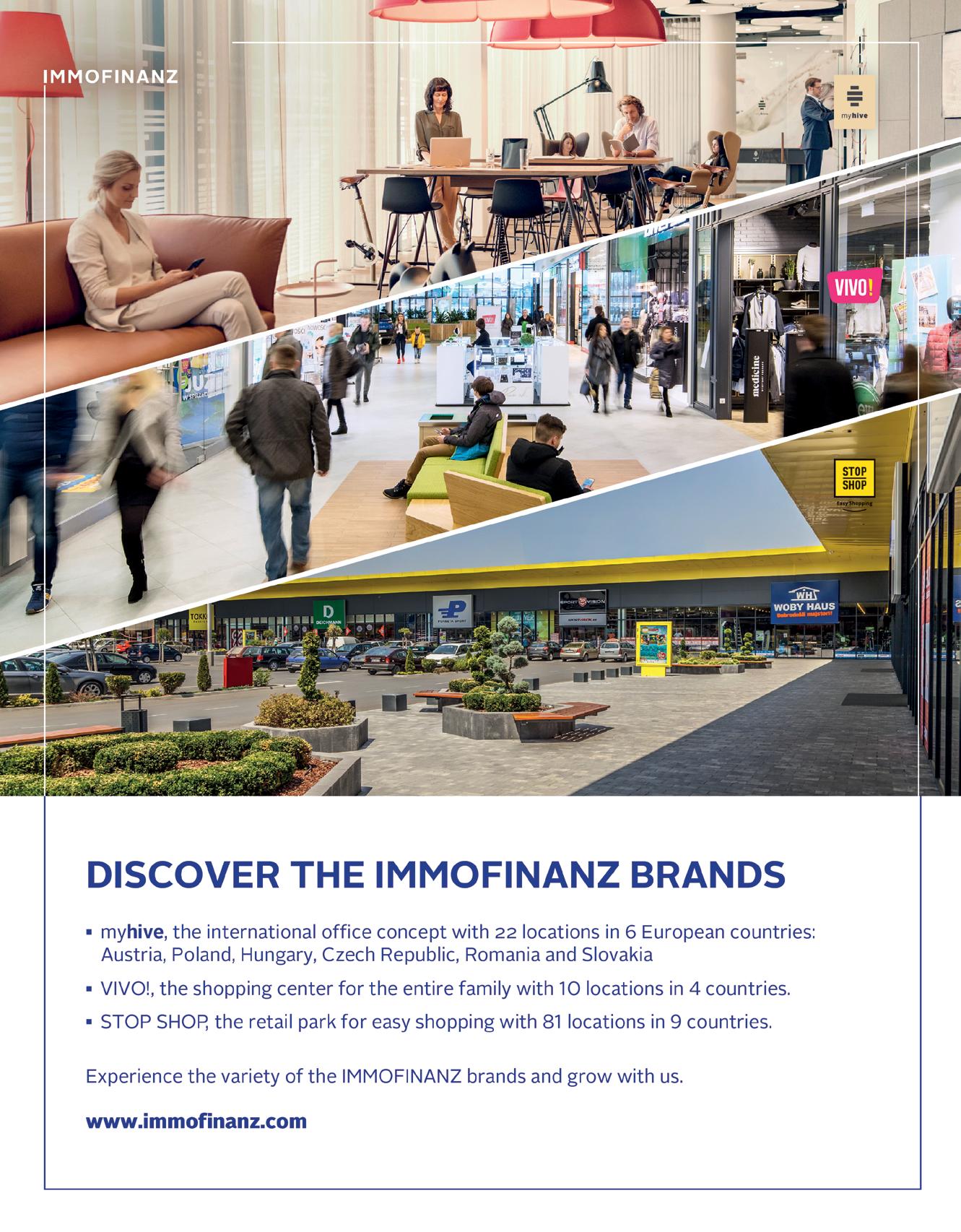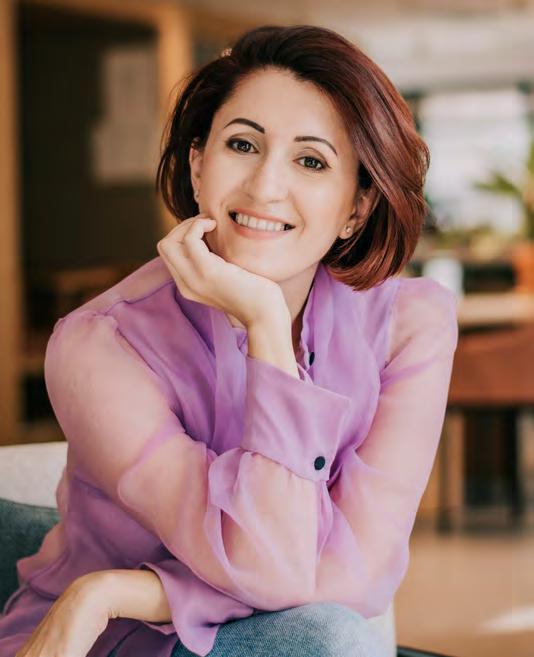
21 minute read
PODCASTS TAKING OVER IN BUSINESS & ENTERTAINMENT
from BR/07/2020
From banking to e-commerce, marketing, retail or deco, any company can have a podcast these days, regardless of its size or international or local reach. Right now, there are more than 850,000 active podcasts and more than 30 million podcast episodes worldwide, in more than 100 languages.
By Romanita Oprea
Advertisement
Diana Serban, D Communication

Silvia Mihailescu, ING Bank Romania
Why are podcasts a trend among companies today? According to Robert Katai, content and communication manager at Bannersnack, the entire content marketing ecosystem is based on two important elements: content creation and marketing strategy. And when we think about content creation, we should keep in mind that there are four types of content: text, photo, video, and audio.
“There was a time when blogging was on the rise. Every company had started their own blog page. Every journalist had a blog as a side project and within a few years they had turned it into a business worth millions. Then the video revolution began, so companies started to also look at video marketing. YouTubers became the new celebrities of the internet and video consumption was on the rise,” said Robert Katai.
As he notes, we are now witnessing an audio revolution. Between video and text, audio is giving the consumer a sense of belonging. People love to consume podcasts because it’s not just entertainment. “Active people don’t have time to consume active content (video or text). Active people love passive content, the one that lets you do something else while you are listening to your favourite new episode. And when brands know how to serve their consumers’ interest in an audio format, they will win in the podcasting world,” Katai added.
Andreea Vrabie, the host of DoR’s “Pe bune” podcast, knows how to put things into perspective and reminds us that podcasts
have been trending globally for some years now. It was the investigative journalism podcast Serial launched in 2014 that opened up podcasts to the mainstream audience through the compelling story of Adnan Syed, a teenager who might have been wrongly accused of murdering his girlfriend in 1999.
“What makes podcasts unique is that you can listen to them while doing other activities: commuting to work, jogging, cleaning the house. You don’t have to allocate time to them like you do for books or TV series; the time is already there and you can fill it up with information. I think this is what has made podcasts trend internationally: people realised that they could use the time they already had to learn something, to listen to a good story or just to entertain themselves,” explained Vrabie. She believes that podcasts in Romania are still in the beginning, although they have been picking up traction in the past year. “There are lots of shows, I think over 150, but the audience is still small, in the thousands. Most Romanian podcasts (about 90 percent) are interview podcasts, so we still lack diversity. When we have more narrative or fiction or investigative journalism shows, that could draw a larger and more diverse audience, then we could talk about podcasts trending in our country,” said Pe bune’s creator.
In turn, Silvia Mihailescu, marketing and communications director at ING Bank Romania, says that in the “right now” context, namely the COVID-19 pandemic and the lockdowns we’ve had all around the world, podcasts have become a hot trend, including due to the fact that it is so much easier, cheaper, and quicker to produce audio ads. And many brands – especially those outside Romania – have chosen to produce podcast ads in a maximum of two days rather than go

for TV campaigns that would have required several weeks. Therefore, in terms of easily adapting to a crisis and producing something quickly, podcasts worked like a charm.
“Looking at the bigger picture on why podcasts in general are becoming more relevant for companies, there is another simple reason: people nowadays watch and listen rather than read and write. So, in addition to the existing “easy to watch” channels, we are now going for the ”easy to listen” one – which is a podcast, both for internal and external communications,” said Silvia Mihailescu.
The third reason, and something that it is important for every brand, is that podcast listeners are in general better educated and have higher incomes. And that makes them a great audience if your marketing strategy is aimed at this kind of segment. “The fourth reason is that podcast consumers are a holy grail when it comes to advertising – around 70 percent remember brands and products from podcast ads and a similar number make a purchase after hearing an ad in a podcast, according to IAB.com. So as a brand, although you’d pay more to get to a podcast audience when it comes to CPM, you would reach a very engaged audience, who is very loyal to the show’s host and to the topic,” said ING’s representative. According to Diana Serban, owner of D Communications, podcasts are a trend because they exploit a sense we haven’t used very much in marketing until now: hearing. It is a communication channel that can be accessed anytime and anywhere, and the attention span is huge. Moreover, the content is engaging and convenient for listeners, there is a mobile-friendly content option, with audiences that are very loyal (podcast listeners are 20 percent more likely to connect with a brand on social media). In other words, podcasts are a very good tool to create awareness and engagement. “Last but not least, I’d say brands are also doing more around podcasts because they trust them more – we’re seeing more investment on this side from both a content and a measurement perspective,” Silvia Mihailescu explained.
THE CREATION PART There is a long distance between knowing how and why podcasts work to actually creating one. Building real storytelling is not easy and requires some steps and inspiration. First of all, one has to define the message or messages they want to deliver, as a brand, through the podcast. Diana Serban recommends that the message not be extremely commercial because people feel when you’re
trying hard to sell them something. Listeners will tune out quickly if you treat your podcast like a 30-minute sales spiel. “Telling stories that involve your products or brand values is more efficient that explicitly talking about your products. Because in this way you manage to get people’s attention in a noninvasive way. While paying attention to the story, they are in touch with the brand too. The purpose is not necessarily to sell through a podcast, but to be inside the consumer’s mind almost all the time or as much as possible,” said Serban.
“To me, it is the overall Listener Experience (LX) that matters. And yes, there is a name for it nowadays, because it is really important. Keeping the audience hooked and engaged takes a lot of work. As usual, a great experience starts with empathy, understanding the audience and its needs, not just trying to do something “because you think it’s important” or “because you have to sell it”. Then obviously, like with video, you need your data to build the story – and this is a bit of a challenge, because podcast & audio data is both all over the place and nowhere. But the audio industry is getting a bit better at this. Other important aspects are that you need to think a bit in terms of episodes, and envision the red thread for your audience,” Mihailescu argued.
In Robert Katai’s mind, it’s very important to have your own voice and have a story to tell. “Other podcast creators are always asking me why they should create a podcast, and I tell them it’s because no one can tell your story the way you tell it. We need more stories in our lives. And guess what, there is a story at every corner, in every discussion, every day. All you have to do is go out, find them, give them a voice and let people know about them. Just think about how a story was told back in ancient times. It was word of mouth marketing, right? Well, that’s exactly what podcasting is today. You will hear a
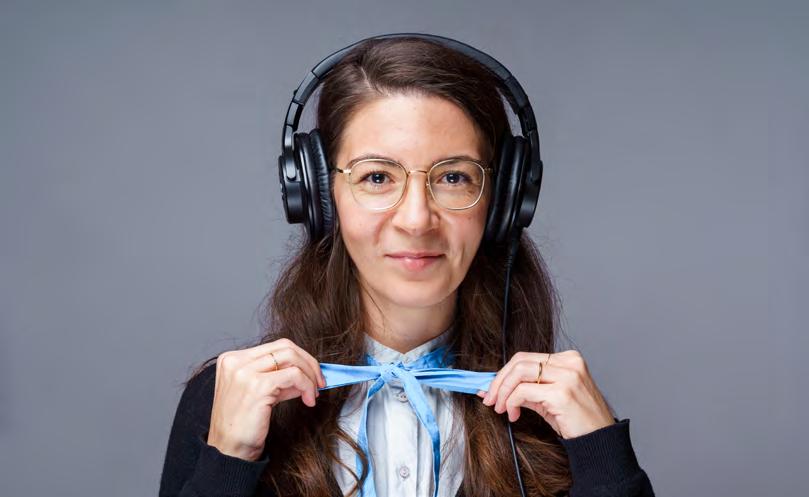
good story and you will make sure to tell everyone about it. Because it’s helping you have a better position in your community,” said Katai.
“You want to put in all the ingredients that make a good story: you want to hear and “see” (describe) the characters, to imagine the place where they are, you want details about the events they are talking about, you want action that moves the story along, you want them to convey emotion and to impart knowledge, and as a listener, you also want to feel transformed after listening to the story. So, from this point of view, podcasts are not that different from any other media (text, film, TV shows). But audio has the advantage that you can hear the emotion in a person’s voice (a laugh, a sigh, a pause that tells you something) and it creates a sense of intimacy because you can’t see that person, it’s just you and the story they are telling thorough your headphones and it’s more easy to connect with them and their story,” Andreea Vrabie concluded. How does one create high quality content with a podcast? In Serban’s opinion, there is nothing more creative than authenticity. The key is to avoid reading text, because people will get bored. They want to listen to your true opinion on a topic, they like to feel when you have doubts about something, when you laugh… this is the way you can spice up your podcast. “Don’t be afraid to stutter; it is so normal and human that nobody will take it as a bad point. The most creative podcasts are those that get the listener very close to a raw experience. Sound effects make a huge difference. For a professional podcast, I recommend that you work with a professional team who can help you properly record and edit your podcast,” said Serban. Coming back to the Listener Experience, ING’s representative reiterates some very important aspects: knowing the audience, showing empathy, running your research (and having that data), being consistent, fun, and keeping that red thread across your episodes. “What I’d say could make it or break it is understanding how audio works as a medium. And here I see radio people and agencies who have worked with audio publishers as having both an advantage and the responsibility to educate everyone else. Because audio content is more immersive, it’s right there between your ears, it needs to be addressed differently than TV and social media. And I am not just talking about exploring 3D audio, but also about understanding how our brains are wired to listening to information in a certain sequence, how low and high tones help us remember things and more. One of the first things I’d probably recommend to someone who’d love to start a podcast would be to understand how audio works in general,” Silvia Mihailescu argued.
Waste management, recycling, and the circular economy at the 2020 Environmental & Sustainability Summit
Waste management, clean water, forest protection and restoration, recycling, and the circular economy are among the most important topics in the European Union today, and they were all discussed at Business Review’s recent Environmental & Sustainability Summit, which brought together representatives of the European Commission, Romanian authorities, and large companies.
By Aurel Constantin
The coronavirus crisis has shaken the world to its core and has tested healthcare and welfare systems as well as the entire society. But, as Marius Vascega, the European Commission’s Head of Cabinet for Environment, Oceans and Fisheries, says, “we cannot lock ourselves into obsolete technologies and business models from the past.” He pointed out that the EC was putting forward a two-fold response: the Next Generation EU, a EUR 750 billion recovery instrument from 2021 to 2024, and the long-term budget for 2021 – 2027, worth EUR 1.85 trillion.
In Romania, the environmental fund’s budget for 2020 is the largest in history at RON 2.8 billion, as Mircea Fechet, State Secretary at the Ministry of Environment, Water and Forests pointed out at the Summit. “Romania joined the group of European Union states which have accepted the fact that the coronavirus pandemic should be a driver for the economic recovery of the Green Deal. “The fact that we have accepted this political decision at the government level and that ministers understood that it was very important to join these states is something that will help us a lot in the future,” said Mircea Fechet. But the Green Deal is not and the recovery plans are not yet finalised. “The recovery plan has several loopholes that need to be remedied. For example, there is no approach to pollution with toxic substances, which is a major threat to our health. Also, the loss of biodiversity through habitat destruction is not mentioned, although it is listed as the main cause for new types of diseases,” said Raul Pop, Program Manager at ECOTECA Association, a member of the European Environmental Bureau.

In Romania, the environmental fund’s budget for 2020 is the largest in history
STEPS IN THE RIGHT DIRECTION Over the last 2 years, many companies have adopted sustainability as a business model. “There are certain measures that we take for a sustainable model that will reduce the negative impact on society,” said Valer Hancas, Corporate Affairs & Communication Director at Kaufland Romania & Moldova. Last year, the retail chain introduced the measure of selling food bags instead of giving them out for free and decided to get rid of disposable bags. “The consumption per customer was about 80 bags per month and we hoped to reduce the number of disposable bags by 30 percent. The surprise was that 2 months after implementation, the use of disposable bags was down by 65 percent,” said Hancas.
Unfortunately, the pandemic has forced some environmentally damaging measures to be taken. For example, retailer Cora said that, for health-safety reasons, they had to pack more fruits and vegetables than usual. “We wanted to sell more unpackaged fruits and vegetables, but for health-safety reasons, many goods must be packaged, so we ended up using more plastic,” said Emanuel Parvulescu, Head of Environment at Cora.
“In Romania, we still don’t have a system for efficient recycling, which could lead us to a circular economy,” said environmental expert Ionut Georgescu. But as the crisis has given us a new perspective on life and we have realised that we can be just as happy while consuming less, it has also given us reasons to trust technology. “I believe that technology and digitalization can change this industry much faster than local authorities can. That is why, within the FWEI group, we focus on technology,” said Ionut Georgescu.
He also announced a new educational project, called The Movement for Recycling, a project developed for social media and meant to convince as many people as possible to take action, to be responsible, and to change their perception of selective waste collection.
Reshaping cultural businesses

With all major events cancelled, cultural businesses have had to resize and reinvent themselves for both the public’s safety as well as for the creative act. So, who is reshaping cultural experiences?
By Oana Vasiliu
Rocanotherworld vibes Rocanotherworld Festival decided to stay on, and the event took place on June 25-28 in Iasi. “The biggest challenge would have been cancelling this year’s edition of the festival altogether. We have decided to carry on, to show ourselves and our audience that, regardless of the context, we will keep this time and this place that are very special to us. Besides that, it is obvious that reducing a 40,000-visitor event to one with just 2,500 attendees, with just one stage and only 3 bands performing each day, leaving out the art, food, and many of the other aspects we had developed over the years weren’t easy decisions to make, but we had this opportunity and we decided to seize it, with all the safety measures required,” Patricia Butucel, Rocanotherworld Festival Director, told BR.
Garana Jazz Festival is also due to take place between August 6-9. “We had to rethink everything. (…) We gave up two of the three stages: the Catholic Church in Valiug and the courtyard of the La Rascruce inn, which had too little space to allow us to maintain the required distance. Then we had to limit the number of attendees to 500, and that meant that the tickets were sold out within a few hours. (…) For this edition, we wanted to bring some of the most valuable music projects currently available in European jazz. I invited the David Helbock Trio from Austria, the Quadrivium quartet from Germany, whose leader is the trumpeter Markus Stockhausen, one of the best in the world. (…) Also from Germany, a duo formed by German pianist Edgar Knecht and the holder of two ECHO Jazz awards – trumpeter Frederik Köster. (…) Another project that started from old musical traditions in the Balkans is the Vasko Atanasovski Adrabesa Quartet, which brings together musicians from Slovenia, Italy, and France. (…) This is just a part of the line-up. Other musicians will confirm their participation,” says Marius Giura, director of
MUSIC
Garana Jazz Festival. FILM TIFF is going to take place in Cluj-Napoca between July 31 - August 9. “The public should expect a TIFF-boutique festival, which will have an adapted programme but will keep the characteristics the TIFF brand has demonstrated in its 18 years so far. Of course, the festival will look different because of the safety measures we must take for the audience, so there will no longer be the same crowds, there will be fewer guests and parties, and some concerts will not be able to
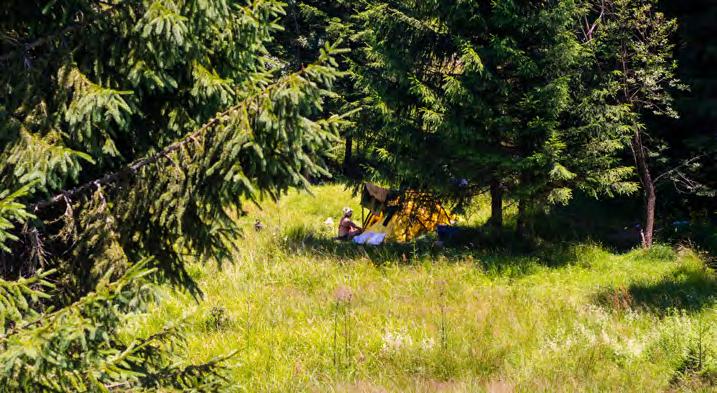
Drive-in cinema experience in Snagov
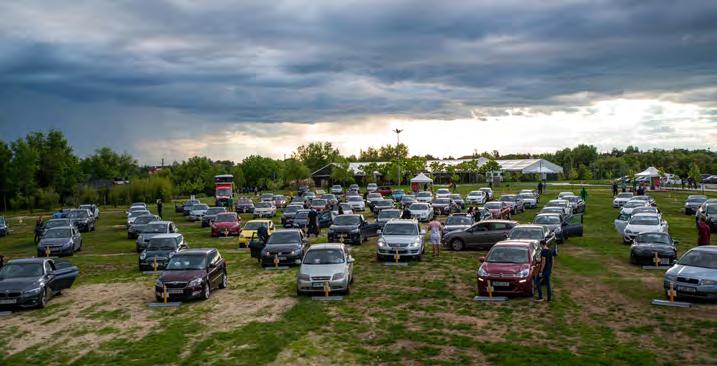

Ideo Ideis outdoor activities
Romexpo offers drive-in cinema experience
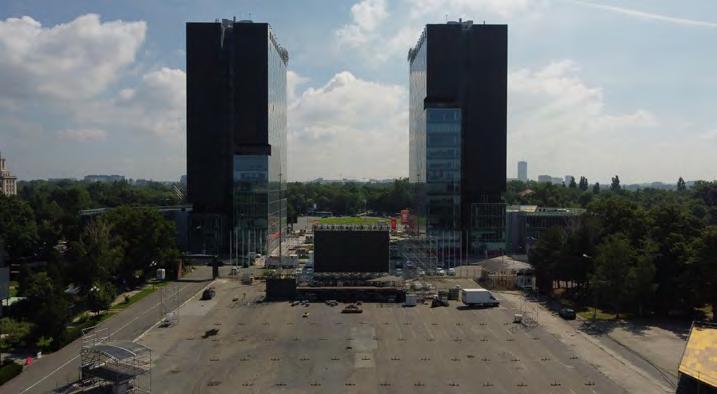
take place. But the TIFF spirit will be there, it will be an authentic edition, with many good films, including Fellini’s most famous pieces, screened from restored copies. We will make the closing more informal, in Unirii Square – the public can certainly expect warmth and familiarity,” says Tudor Giurgiu, the president of TIFF.
THEATRE IDEO IDEIS Festival, which celebrates its 15th anniversary this year, will take place as usual, between August 5-9, but in a new version, happening not just in Alexandria (Teleorman County) but also in Baia Mare, Botosani, Bucuresti, Buzau, Campina, Roman, Sibiu, and Timisoara. “We haven’t resized the festival as much as we’ve “decentralised” it. It’s all the more interesting because IDEO IDEIS wasn’t a very central festival to begin with; it’s not located in any of Romania’s big cities, but in Alexandria, a city that’s infamous for not having a library nor a theatre. For this year’s edition we decided that since it would be impossible to bring everyone together for the festival, we could be the ones going to them, as a way of saying thank you for being a part of IDEO IDEIS for 15 years, by bringing the festival to the participants’ home towns. Instead of one big anniversary event, the festival will take place in 9 cities in Romania at the same time, and instead of having a few larger venues, we will have several small venues where small groups of people will get together. We are happy that the festival atmosphere is so effervescent that we are reasonably confident that the 9 festival capsules will be able to recreate part of the atmosphere in each of these cities,” explains Oana Furdea, the director of IDEO IDEIS. NEW EXPERIENCES: DRIVE-IN CINEMA Bucharest residents can attend outdoor events in two locations – Event Park Snagov and Romexpo – which were redesigned as drive thru cinemas. “Event Park Snagov is a brand and concept which was developed and created during the lockdown and launched on June 1. It was meant to be a highly adaptable concept, ready to be turned into a location where you could organize all kinds of outdoor events, not just a drive-in cinema, but also concerts, stand-up comedy shows, outdoor parties, and many more. As for the screen, it was built during the lockdown, at the beginning of May. DriveIn Romexpo is the second outdoor event space, created by UNIVERSUM in partnership with Romexpo and Arena Events, which will initially have 183 seats available and a large FULL HD LED screen. It is a new experience at the heart of Bucharest and it is the largest space built for drive-in events in the city. The drive-in features a wide range of films, from new releases to old classics, as well as live concerts on the big screen.
Both DriveIn Romexpo and Event Park Snagov were conceived as escape options from the urban bustle. At a drive-in, one can have privacy and a feeling of freedom; from inside the vehicle, they can adjust the volume, air conditioning and heating to their own preference. It is a truly an alternative form of entertainment: cinema plus dinner in the same place, with comfortable and quick access, while keeping the distance recommended by the authorities,” added Cristian Hossu, managing partner at UNIVERSUM.
The state of TIFF: On screen with Mihai Chirilov
The Transylvania International Film Festival (TIFF) has managed to resize and yet still offer the cinema experience to cinephiles, as it has been doing for the past 19 years. While details were still being worked out for the July 31-August 9 period, Business Review talked to Mihai Chirilov, TIFF’s artistic director, about the state of cinema during the pandemic.
By Oana Vasiliu
Inevitably, the TIFF budget has suffered, and some sponsors have withdrawn as they reviewed their priorities. The restrictions in place and the anticipated maximum capacity of 30-50 percent in cinemas require not only a reduction in the number of films (by about 25-30 percent) and cinema-goers, but also a reconfiguration of the programme, to facilitate the introduction of safety measures, including the disinfection of spaces and the longer time intervals between screenings in order to lower the risks for the public. Many of the planned new sections of this year’s TIFF will be carried over to the next edition, while the number of films in each existing section has also been reduced – but we have tried to maintain the basic structure of the festival, which is familiar to our fans: the main competition (open to young directors at their first or second film), and the classic sections Supernova, Full Moon, No Limit, What’s Up, Doc?, 3x3, Hungarian Day, Film Food, EducaTIFF, spotlight on national cinema, retrospectives, Fellini homage, cine-concerts, and special screenings. What is cinema going to look like after the pandemic? Are we moving online or is the movie theatre experience still the preferred option? Is drive-in cinema returning? I have no idea what the post-pandemic cinema will look like. Maybe some will take this as a challenge and rethink the production process and the stories as they happen. Others may continue to tell their stories as if nothing happened. Some may move online while others will prefer to stick to the general idea that a movie can only really be experienced in the darkness of a movie theatre and adapt to the new reality and rules in order to take this tradition further. It remains to be seen whether the drive-in experience turns out to be satisfactory – in my opinion, I think that you can only see a certain kind of film from your car, which has to be technically adapted
You are going to resize the TIFF. What should we expect in terms of the film selection?

to this limiting viewing mode. What’s not to be missed this year at TIFF? Federico Fellini’s retrospective, 100 years after the birth of one of the most special filmmakers who ever existed. The opportunity to see Fellini’s masterpiece La dolce vita on a giant outdoor screen seems unmissable to me – and the kind of ironic but therapeutic counterpoint to the immediate reality, in which life is not necessarily as sweet as it was before. There are also the new films by cinema maestros Roman Polanski, Arturo Ripstein, Alejandro Amenabar, Marco Bellocchio, but also this year’s Berlin Golden Bear, There Is No Evil. The Barefoot Emperor, a sequel to King of Belgium, which opened at TIFF a few years ago, is a welcome infusion of humour and social comment on today’s Europe. The Hungarian film Eden is a limiting, visually splendid experience, about life in isolation. Screenings in restored versions with Lucian Pintilie’s Libra (Balanta), David Cronenberg’s Crash or Water as a Black Buffalo, the documentary about the devastating floods that happened 50 years ago, to which most of the essential filmmakers of Romanian film contributed, are all unmissable events for any film lover. I’ll also mention the cine-concert with Murnau Faust’s masterpiece, the 3D documentary about choreographer Merce Cunningham, the Costa Gavras mini-retrospective, and last but not least, Cristi Puiu’s new film, Malmkrog.

